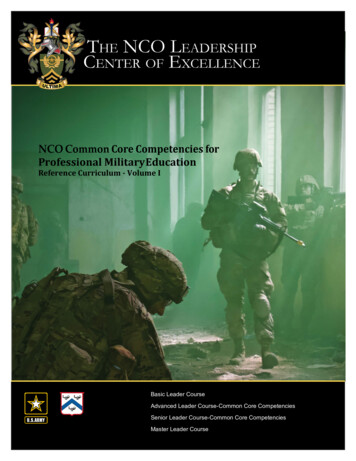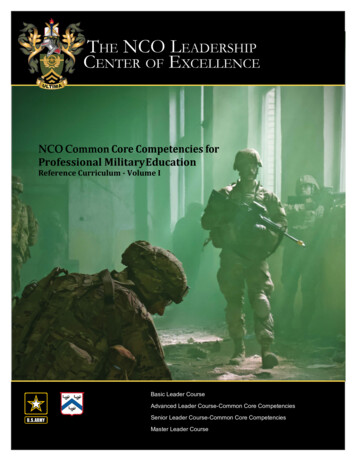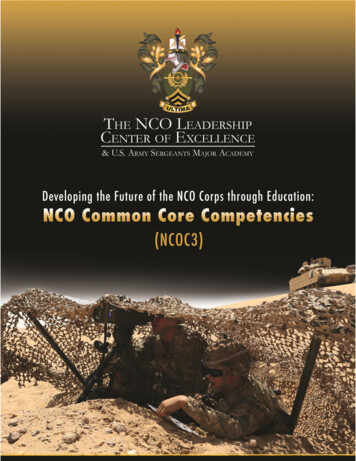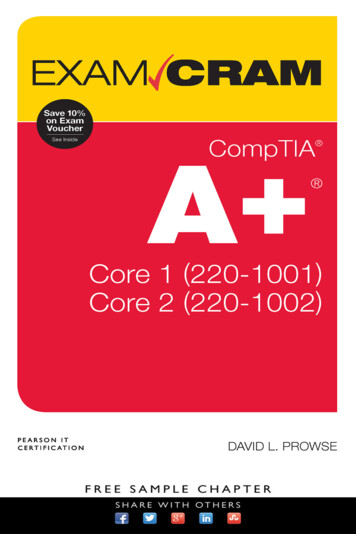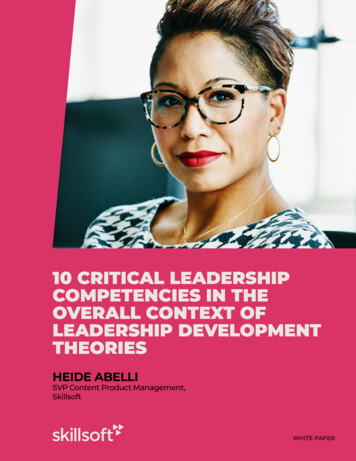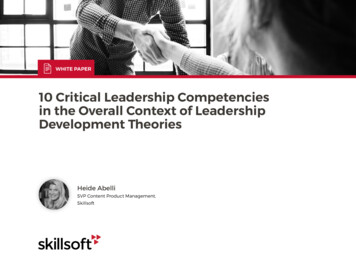
Transcription
Leadership TrackSection5ARMY CORE LEADERCOMPETENCIESKey Points1Leading2Developing3AchievingeArmy leaders in this century need to be pentathletes,multi-skilled leaders who can thrive in uncertain andcomplex operating environments . innovative andadaptive leaders who are expert in the art and scienceof the profession of arms.Dr. Francis J. HarveySecretary of the ArmySpeech for US Army Command and General Staff College graduation (2005)
Army Core Leader CompetenciesIntroductionLeaders provide purpose, direction, and motivation. Army leaders work hard to leadpeople, to develop themselves, their subordinates, and organizations, and toaccomplish their missions across the spectrum of conflicts.But continuously building and refining your values and attributes, as well asacquiring more professional knowledge, is only part of becoming a competent leader.Leadership succeeds when you act and apply the core leader competencies. As youmove from direct leadership positions to the organizational and strategic leader levels,those competencies will take on different nuances and complexities.GEN Matthew B. Ridgway exemplified the qualities of a true Army leader in twowars.Achieving Success and Leadership ExcellenceGEN Matthew B. Ridgway successfully led the 82d Airborne Division and XVIIIAirborne Corps during World War II. He later commanded the Eighth (U.S.) Armyduring the Korean War. GEN Ridgway exemplified the qualities of the competentand multiskilled Army leader. His knowledge of American Soldiers, other services,allies, foreign cultures, and the overall strategic situation led him to certainexpectations.Those expectations gave him a baseline from which to assess his commandonce he arrived in theater. He continually visited units throughout the EighthArmy area, talked with Soldiers and their commanders, assessed commandclimate, and took action to mold attitudes with clear intent, supreme confidence,and unyielding tactical discipline.GEN Ridgway constantly sought to develop and mentor subordinate commanders and their staffs by sharing his thoughts and expectations of combat leadership. He frequently visited the frontlines to feel the pulse of the fighting forces,shared their hardships, and demanded they be taken care of. He took care of histroops by pushing the logistic systems to provide creature comforts as well as warsupplies. He eliminated the skepticism of purpose, gave Soldiers cause to fight,and helped them gain confidence by winning small victories. GEN Ridgway led byexample. His actions during four months in command of the Eighth Army prior tohis appointment as United Nations Supreme Commander bring to life the leader’scompetencies. He left a legacy that leaders can operate within the spheres of alllevels of leadership to accomplish their mission consistently and ethically. 55
56 SECTION 5Figure 5.1 shows the Army Leadership Requirements Model. You will refer to this modela great deal during your ROTC studies. On the left are the attributes you’ve been studyingin Sections 2 through 4—character, presence, and leader intelligence or intellect. On theright are the core leader competencies you’ll read about in this section—leading, developing,and achieving.LeadingThe leading category includes four leader competencies. Two focus on who you are leadingand with what degree of authority and influence: leads others and extends influence beyondthe chain of command. The other competencies address two ways by which you conveyinfluence: leads by example and communicates.Leads others involves influencing Soldiers or Army civilians in your unit or organization.This competency has a number of components, including setting clear direction,enforcing standards, and balancing the care of followers against mission requirements.Extends influence beyond the chain of command requires the ability to operate in anenvironment, including both higher and lower command structures, and using yourinfluence outside the traditional chain of command. This includes connecting withjoint, allied, and multinational partners; local nationals; and civilian-led governmentalor nongovernmental agencies. In this area, you must often operate without designatedauthority or while others do not recognize your authority.Leads by example is essential to leading effectively over the course of time. Whetheryou intend to or not, you provide an example that others consider and use in whatFigure 5.1 The Army Leadership Requirements Model
Army Core Leader Competencies 57they do. This competency reminds you to serve as a role model. Your actions shouldbe grounded in the Army Values and imbued with the Warrior Ethos.Communicates ensures that you gain a clear understanding of what needs to be done,and why, within your organization. This competency deals with maintaining a clearfocus on the team’s efforts to achieve goals and tasks to accomplish missions. It helpsbuild consensus and is a critical tool for successful operations in diverse multinationalsettings. You refine your communicating abilities by developing advanced oral, written,and listening skills.Leads OthersAll the Army’s core leader competencies, especially leading others, involve influence. Youcan draw on a variety of techniques to influence others. These range from obtainingcompliance to building a commitment to achieve. Resistance is the opposite of complianceand commitment. There are many techniques for influencing others to comply or commit,and you can use one or more of them to fit to the specifics of any situation.Compliance-focused influence is based primarily on your authority. Giving a directorder to a follower is one approach to obtaining compliance during a task. Compliance isappropriate for short-term, immediate requirements and for situations where little riskcan be tolerated. Compliance techniques are also appropriate for use with others who arerelatively unfamiliar with their tasks or unwilling or unable to commit fully to the request.If something needs to be done with little time for delay, and there is no need for asubordinate to understand why the request is made, then compliance is an acceptableapproach. Compliance-focused influence is not particularly effective when your greatestaim is to create initiative and high esteem within your team.Commitment-focused influence generally produces longer-lasting and broader effects.Whereas compliance changes only a follower’s behavior, commitment reaches deeper—changing attitudes and beliefs, as well as behavior. For example, when you buildresponsibility among followers, they will likely demonstrate more initiative, personalinvolvement, and creativity. Commitment grows from an individual’s desire to gain a senseof control and develop self-worth by contributing to the organization. Depending on theobjective of the influence, leaders can strengthen commitment by reinforcing followers’identification with the nation (loyalty), the Army (professionalism), the unit or organization(selfless service), the leadership in a unit (respect), and to the job (duty).Influence TechniquesYou can use several specific techniques for influence that fall along the continuum betweencompliance and commitment. The 10 techniques described below seek different degreesof compliance or commitment ranging from pressure at the compliance end to buildingrelations at the commitment end. You apply pressure when you use explicit demands to achieve compliance, such asestablishing deadlines for completing tasks, imposing negative consequences forfailure to complete. Indirect pressure includes persistent reminders of the requestand frequent checking. Legitimate requests occur when you refer to your source of authority to establishthe basis for a request. Exchange is an influence technique that involves making an offer to provide somedesired item or action in trade for compliance with a request. The exchangetechnique requires you to control certain resources or rewards that those you areinfluencing value.compliancethe act of conforming toa specific requirement ordemandcommitmentwilling dedication orallegiance to a cause ororganization
58 SECTION 5 Personal appeals occur when you ask the follower to comply with a request basedon friendship or loyalty. This might often be useful in a difficult situation whenmutual trust is the key to success. Collaboration occurs when you provide assistance or resources to carry out adirective or request. You make the choice more attractive by being prepared tostep in and resolve any problems. Rational persuasion requires you to provide evidence, logical arguments, orexplanations showing how a request is relevant to the goal. This is often the firstapproach to gaining compliance or commitment from followers. Apprising happens when you explain why a request will benefit followers, such asgiving them greater satisfaction in their work or saving them time. In contrast tothe exchange technique, the benefits are out of your control. Inspiration occurs when you fire up enthusiasm for a request by arousing strongemotions to build conviction. By appropriately stressing the results of strongercommitment, you can inspire followers to surpass minimal standards and reachelite performance status. Participation occurs when you ask a follower to help plan how to address a problemor meet an objective. Active participation leads to an increased sense of worthand recognition. It provides value to the effort and builds the follower’s commitmentto execute. Relationship building is a technique in which you build positive rapport and arelationship of mutual trust, making followers more willing to support requests.Examples include showing personal interest in a follower’s well-being, offeringpraise, and understanding a follower’s perspective.Putting Influence Techniques to WorkTo succeed and create true commitment, others should perceive your influencing techniquesas authentic and sincere. Positive influence comes when you do what is right for the Army,the mission, the team, and each individual Soldier. Negative influence—real and perceived—happens when you focus primarily on personal gain and lack self-awareness. Even honorableintentions, if wrongly perceived by followers as self-serving, will yield mere compliance.False perception may trigger unintended side effects such as resentment toward you anddeterioration of unit cohesion.When influencing followers, you should consider that: the objectives for the use of influence should be in line with the Army Values, ethics,the Uniform Code of Military Justice, the Warrior Ethos, and the Civilian Creed various influence techniques can be used to obtain compliance and commitment compliance-seeking influence focuses on meeting and accounting for specific taskdemandseThe American Soldier demands professionalcompetence in his leaders. In battle, he wants to knowthat the job is going to be done right, with nounnecessary casualties.Omar N. BradleyGeneral of the Army (1950-1953)
Army Core Leader Competencies commitment-encouraging influence emphasizes empowerment and long-lastingtrust.Extends Influence Beyond the Chain of CommandWhile Army leaders traditionally exert influence within their unit and its established chainof command, as a multiskilled leader you must also be able to extend influence to othersbeyond your chain of command. Extending influence is the second leader competency. Intoday’s politically and culturally charged operational environments, even direct leadersmay work closely with joint, interagency, and multinational forces, the media, local civilians,political leaders, police forces, and nongovernmental agencies. Extending influence requiresthat you be especially aware of the differences in how influence works.When extending influence beyond the traditional chain, you often have to influencewithout authority designated or implied by rank or position. You may find yourself insituations where you must build informal teams to accomplish organizational tasks.A unique aspect of extending influence is that those who are targets of your influenceoutside the chain may not even recognize or willingly accept your authority as an Armyleader. The key element of extending influence and building teams is for you to create acommon vision among prospective team members.Leading without authority requires adapting to your environment and the culturalsensitivities of the given situation. You must have cultural knowledge to understand differentsocial customs and belief systems and to address issues in those contexts. When conductingpeace operations, for example, you must understand that interaction with locals and theirleaders can have dramatic impacts on the overall theater strategy. The manner in whichyour unit conducts house-to-house searches for insurgents can influence the localpopulation’s acceptance of authority, or become a recruiting incentive for the insurgency.Extending influence includes competency in: building trust outside lines of military command authority understanding the sphere, means, and limits of influence negotiating, building consensus, and conflict resolution.Building Trust Outside Lines of AuthorityForming effective, cohesive teams is often the first challenge when you work outside atraditional command structure. These teams usually have to be formed from disparategroups who are unfamiliar with military and Army customs and culture. Without somemeasure of trust, nothing will work well. To establish trust, you will have to identify areasof common interests and goals. Trust between two people or two groups is based largelyon being able to anticipate what others understand and how they will respond in varioussituations. Keeping others informed also builds trust. Cementing and sustaining trustdepends on following through on commitments.Building alliances is similar to building teams. The difference is that in alliances thegroups maintain greater independence. Trust is a common ingredient in effective alliances.Alliances are groomed over time by establishing contact with others, growing friendships,and identifying common interests.Understanding Sphere, Means, and Limits of InfluenceWhen you operate with an established command structure and common procedures,everyone’s roles and responsibilities are readily apparent. When you lead outside anestablished organization, your ability to assess the parties involved becomes another partof the operation. Identifying who is who, what role they have, over whom they haveauthority or influence, and how they are likely to respond to your influence, are allimportant considerations. 59
60 SECTION 5The key to influence outside the chain of command is to learn about the people andorganizations. By understanding their interests and desires, you will know what influencetechniques are most likely to work.Negotiating, Building Consensus, and Resolving ConflictWhile operating outside the chain of command, you often have to resolve conflicts betweenArmy interests and local populations or others. Conflict resolution identifies differencesand similarities among the stances of the various groups. You analyze differences tounderstand what is behind them. You can make proposals for reinterpreting the differencesor negotiating compromise to reach common understanding or shared goals. Trust,understanding, and knowing the right influence technique for the situation are thedetermining factors in negotiating, consensus building, and conflict resolution.Leads by ExampleDisplaying CharacterAs an Army leader you set an example whether you know it or not. A leader of soundcharacter exhibits good character at all times. Modeling the attributes of good characterdefines you to the people with whom you interact. As a leader of character you do not haveto worry about being seen at the wrong moment doing the wrong thing.When you live by the Army Values and the Warrior Ethos you display character andlead by example. This means putting the organization and your subordinates above personalself-interest, career, and comfort. For the Army leader, it requires putting the lives of othersabove a personal desire for self-preservation.Leading With Confidence in Adverse ConditionsWhen you project confidence you are an inspiration to followers. Soldiers will follow leaderswho are comfortable with their own abilities; they will question the leader who showsdoubt.Displaying confidence and composure when things are not going well can be a challengefor anyone. However, it is important when your task is to lead others through a gravesituation. As you have read, confidence is a key component of leader presence. A leaderwho shows hesitation in the face of setbacks can trigger a chain reaction among others.On the other hand, a leader who is overconfident in difficult situations may lack the properdegree of care or concern.Leading with confidence requires a heightened self-awareness and ability to masteremotions. Developing the ability to remain confident, no matter what the situation, involves: having prior opportunities to experience reactions to severe situationsmaintaining a positive outlook when a situation becomes confusing or changesremaining decisive after mistakes have been discoveredencouraging others when they show signs of weakness.Displaying Moral CourageProjecting confidence in combat and other situations requires physical and moral courage.While physical courage allows infantrymen to defend their ground, even when the enemyhas broken the line of defense and ammunition runs critically short, moral courageempowers leaders to stand firm on values, principles, and convictions in the same situation.As a leader with moral courage, you take full responsibility for your decisions and actions.Morally courageous leaders are willing to critically look inside themselves, consider newideas, and change what caused failure.Moral courage is fundamental to living the Army Values of integrity and honor.
Army Core Leader CompetenciesDemonstrating CompetenceIt does not take long for followers to become suspicious of a leader who acts confidentbut does not have the competence to back it up. Having the appropriate levels of domainknowledge is vital for you, in turn, to display confidence through your attitudes, actions,and words.Leading by example demands that you stay aware of how your guidance and plansare executed. You cannot remain in safe, dry headquarters, designing complex plans withoutexamining what your Soldiers and civilians are experiencing. You must have courage to getout to where the action is, whether the battlefield or the shop floor. You must connect withyour followers by sharing hardships and communicating openly to clearly see and feel whatgoes on from a subordinate’s perspective.True warrior leaders lead from the front and share the experiences of their Soldiers.Seeing and feeling the plan transform into action empowers you to better assess the situationand influence the execution by your immediate presence. If you stay at a safe distance fromthe front, you risk destroying your Soldiers’ trust and confidence.GEN George Patton made it clear that leading from the front and making plans witha clear understanding of the front-line situation were keys to success. In his General Ordersto the 3rd Army of 6 March 1944, he stipulated:The Commanding General or his Chief of Staff (never both at once) and one memberof each of the General Staff sections, the Signal, Medical, Ordnance, Engineer, andQuartermaster sections, should visit the front daily. To save duplication, the Chiefof Staff will designate the sector each is to visit.The function of these Staff officers is to observe, not to meddle. In addition to theirown specialty, they must observe and report anything of military importance. Remember, too, that your primary mission as a leader is to see with your own eyesand be seen by your troops while engaged in personal reconnaissance.CommunicatesCompetent leadership that gets result
Leadership succeeds when you act and apply the core leader competencies. As you move from direct leadership positions to the organizational and strategic leader levels, those competencies will take on different nuances and complexities. GEN Matthew B. Ridgway exemplified the qualities of a true Army leader in two wars.

